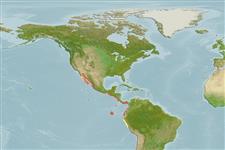Environment: milieu / climate zone / depth range / distribution range
ນິເວດວິທະຍາ
ສັດທະເລ ອາໄສຢູ່ໃກ້ໜ້າດິນໃຕ້ພື້ນທ້ອງນ້ຳ; ລະດັບຄວາມເລິກ 1 - 90 m (Ref. 9342), usually 15 - 30 m (Ref. 9342). Tropical; 32°N - 12°S, 115°W - 76°W
Eastern Pacific: Gulf of California and southern Baja California, Mexico to Peru.
ຂະໜາດ / ນ້ຳໜັກ / Age
Maturity: Lm ? range ? - ? cm
Max length : 34.0 cm TL ຕົວຜູ້/ບໍ່ມີເພດ; (Ref. 86316)
Found on sand and muddy-sand bottoms. Juveniles and small adults are found on fine sand near the coast. Lives to about 6 years (reaching a SL of 20 cm). Feeds on fishes and crustaceans. A synchronous hermaphrodite.
Life cycle and mating behavior
Maturities | ການສືບພັນ | Spawnings | Egg(s) | Fecundities | ຕົວອ່ອນ
Pelagic spawner.
Heemstra, P.C., 1995. Serranidae. Meros, serranos, guasetas, enjambres, baquetas, indios, loros, gallinas, cabrillas, garropas. p. 1565-1613. In W. Fischer, F. Krupp, W. Schneider, C. Sommer, K.E. Carpenter and V. Niem (eds.) Guia FAO para Identification de Especies para lo Fines de la Pesca. Pacifico Centro-Oriental. 3 Vols. FAO, Rome. (Ref. 9342)
IUCN Red List Status (Ref. 130435)
Threat to humans
Harmless
Human uses
ການປະມົງ: ເປັນສີນຄ້າ
ເຄື່ອງມື
Special reports
Download XML
ແຫຼ່ງອີນເຕີເນັດ
Estimates based on models
Preferred temperature (Ref.
123201): 20.4 - 28.7, mean 25.9 °C (based on 56 cells).
Phylogenetic diversity index (Ref.
82804): PD
50 = 0.5002 [Uniqueness, from 0.5 = low to 2.0 = high].
Bayesian length-weight: a=0.00832 (0.00530 - 0.01305), b=3.14 (3.01 - 3.27), in cm total length, based on LWR estimates for this species & Genus-body shape (Ref.
93245).
ຊັ້ນເຂດຮ້ອນ (Ref.
69278): 4.0 ±0.66 se; based on food items.
ຄວາມຢືດຢຸ່ນ (Ref.
120179): ຂະໜາດກາງ, ປະຊາກອນຕຳ່ສຸດທີ່ໃຊ້ເວລາສອງເທົ່າ 1.4 - 4.4 ປີ (Preliminary K or Fecundity.).
Fishing Vulnerability (Ref.
59153): Low vulnerability (24 of 100).
Nutrients (Ref.
124155): Calcium = 141 [55, 257] mg/100g; Iron = 0.989 [0.532, 1.872] mg/100g; Protein = 17.8 [16.0, 19.5] %; Omega3 = 0.268 [0.159, 0.459] g/100g; Selenium = 51.6 [28.3, 101.6] μg/100g; VitaminA = 29.2 [10.2, 96.6] μg/100g; Zinc = 1.07 [0.77, 1.59] mg/100g (wet weight);
